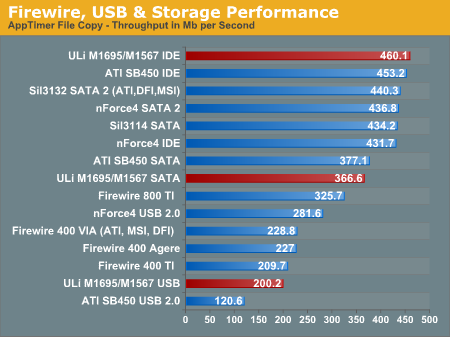ULi M1695 PCIe/AGP for Athlon 64 – Part 2 with SLI
by Wesley Fink on August 5, 2005 10:00 AM EST- Posted in
- Motherboards
USB, Firewire & Storage Performance
After looking at many options for Firewire and USB testing, we finally determined that an external USB 2.0, Firewire 400, and Firewire 800 hard disk might be a sensible way to look at USB and Firewire throughput.Our first efforts at testing with an IDE or SATA drive as the "server" yielded very inconsistent results, since Windows XP sets up cache schemes to improve performance. Finally, we decided to try a RAM disk as our "server", since memory removed almost all overhead from the serving end. We also managed to turn off disk caching on the USB and Firewire side by setting up the drives for "quick disconnect" and our results were then consistent over many test runs.
We used just 1GB of fast 2-2-2 system memory set up as a 450MB RAM disk and 550MB of system memory. Our stock file was the SPECviewPerf install file, which is 432,533,504 bytes (412.4961MB). After copying this file to our RAM disk, we measured the time for writing from the RAM disk to our external USB 2.0 or Firewire 400 or Firewire 800 drive using a Windows timing program written for AnandTech by our own Jason Clark. The copy times in seconds were then converted into Megabits per second (Mb) to provide a convenient means of comparing throughput. Higher Rates therefore mean better performance.

Keep in mind that this is the M1567 south bridge, and the one that you will see with the ATI Radeon Xpress 200 north bridge will likely be the M1573/M1575, which also features HD audio instead of AC'97. The M1573/75 have not yet been tested and may perform even better in USB.










46 Comments
View All Comments
Wesley Fink - Saturday, August 6, 2005 - link
The 400 graph has been removed. After considering the questions here it is fair to say the ULi tests were not run under the same test conditions (due to no DDR Voltage controls and limited vCore adjustments) and should not be directly compared. The 242 remains since it was achieved with the same test conditions.Wesley Fink - Friday, August 5, 2005 - link
Yes, this is the only board using the FX57 in OC testing, but we will be testing with the FX57 in the future. Yes, that makes it an unfair comparison.It really was not possible to use our normal OC tests because the Reference board has no memory voltage adjustments at all. We stated this very clearly in the reviews. The option was to report very low results, or to make changes to the test to show how high the board could actually go in overclock (400 clock speed). We chose to show what the board could do on OC, but the results are not directly comparable to past results.
Lonyo - Friday, August 5, 2005 - link
OCZ BOOSTER FFS!!!!Aquila76 - Friday, August 5, 2005 - link
So if you want to run SLI, you have to use that riser card, right? How exactly does that fit in a standard ATX case? The cards are 90 degrees from their normal position. I understand that this is a good board if you're going to use older AGP cards and want an upgrade path; but I would think they could make it a lot cheaper if they left SLI capability off as it seems rather pointless in this format.kmmatney - Saturday, August 6, 2005 - link
I thought the same thing, but yes, its just a prrof of concept - the retail board makers will implement it without the need for a riser card.MarkB - Friday, August 5, 2005 - link
I think it's more of a proof of concept for showing off the chipset's capabilities, instead of making a whole new reference board to house the 2 x8 pci-e slots.I doubt any retail board would use the riser approach.
Sunbird - Friday, August 5, 2005 - link
Here is South Africa the ASRock 939A8X-m based in this ULi chipset has arrived at our local reseller last week.Its a mATX board and has SATA raid and all the other usual stuff. Near the bottom price range of the local market (aka cheap).
grug2k - Friday, August 5, 2005 - link
The AsRock 939AX-M is NOT a ULi M1695 board. It's an old AGP-only board based on the ULi M1689 chipset.lsman - Friday, August 5, 2005 - link
Computex2005 show also has Jetway A695DAG, Chaintech S1695-2WT - Friday, August 5, 2005 - link
This board should be on the short list (hehe, so short there is only one name on it) of boards for the DIY builder looking to keep their current AGP card and move to PCI Express down the road. There are a lot of users that fit that description so this board makes sense in every way. The only downside will be whether the boards are actually produced by some quality vendors who are not stuck on the Nvidia bandwagon.My S754 setup is adequate for any game that I play, so I should be able to make another year on it. After that, S939 and a 3800+ x2 makes more sense, but after buying that, I won't have the $ left to splurge on a mid-high end PCI Express video card. My 6800 cost $295 when I bought it, so moving that to the S939 setup makes financial sense.